QuestionMy bunny is a 5yrs old female. She got weepy eyes 2 weeks ago and then stop eating after 2 days. I brought her to vet. The doc is saying my bunny has infection on the right eye and may get a hair ball problem. The doc gave 'Baytril' the antibiotic and 'Cisapride' to increase her appetite. The doc also did a 'subcutaneous fluid administration' to hydrate my bunny. The doc is asking me to force feed her with 'Oxbow Critical Care' and fresh pineapple juice. My bunny is getting a little bit better after 3 days of the treatment (at least she starts to poop - small and hard poop). However, it seems her condition is going back to day 1, not eating and drinking, no poop. Now she is totally rejecting force feeding with 'Oxbow critical care' and pineapple juice. Weepy eye is not going away and now she is sniffing. There is some white stuff on her nose.
AnswerHi Frankie,
Umm....I see several red flags here. First, I am not a vet. I have many years of experience in treating the sickest of the rabbits. I have the utmost respect for vets. Some of the comments I will make here will contradict your vet. It is not my intention to "flame" your vet. My intention is to share information and my experiences.
I have to ask.....what was done to identify the root cause of the infection in the eye? It's very possible that it is some type of infection. Was the eye stained to look for corneal abrasions or possible ulcers? What appears to be an eye infection could also be an upper respiratory infection or possibly a dental issue. Dental issues are common in older rabbits and flat faced rabbits like Netherland Dwarfs and Holland Lops...but are possible in any rabbit. Was a culture performed on the discharge to identify the potential pathogen?
I am really concerned about the Baytril and Cisparide. Rabbits do not generally get hair balls like dogs or cats. They can get impactions....this is a dehydrated and tightly bond mass of undigested food, mucous and fur. Impactions lead to a condition called GI stasis (this if often misdiagnosed and/or misidentified as a hair ball). Stasis by definition means a ceasing of normal activity. In the case of the digestive system, stasis means the natural movement of the digestive tract has dramatically slowed. If it is not properly addressed, it can quickly deteriorate into a serious and immediately life threatening condition known as ileus. The presentation of stasis is little or no poops, loss of appetite, very lethargic, prefers to "hunker down" and their ears become cold. This condition can cause shock. Stasis is a secondary issue. It is always caused by something else. The most common cause of stasis is improper diet. A healthy adult rabbit's diet should consist of primarily grass hay such as timothy, orchard grass, oat or brome. Hay should be provided free choice. They should always have high quality hay available. Hay is very high fiber....and a rabbit needs a high fiber, low protein diet. The fiber provide the roughage...the pressure that keeps the gut going. It also helps provide a good climate for beneficial bacteria to grow and populate the gut....it is essential for proper digestion. Hay is also the primary was the teeth are worn down. Rabbits have open rooted teeth and they grow constantly. It's not how hard something is...but how chewy...that keeps the teeth worn down. Overgrown molars or incisors can cause stasis. Pellets should be offered in very limited amounts as they contain far too much protein for the average rabbit. Not only will this overly rich diet cause stasis, the excess protein stresses the kidneys. A diet with lot of sugar...mostly treats....can cause stasis. Certain fruits or veggies can cause problems...and believe or not, carrots contain far too much sugar and should be offered in very limited amounts.
Cisapride and other gut motility drugs are very controversial within the veterinary community. I am totally against them and they will never be used on any of my rabbits. Some of these drugs release chemicals from the brain that cause severe contractions part of the intestinal tract. Other drugs in this class stimulate the nerve endings in the gut to cause these contractions. You have to remember several things here. Most of the time the impaction you are trying to move by the contractions is dry and hard. By placing the impaction under the harsh contractions, it becomes even more compacted and dehydrated...the exact opposite of what is needed. The contractions are very painful. Rabbits, as prey animals, interpret pain as being caught by a predator. They can virtually shut themselves down since they fear they will suffer. The slowing gut also causes a drastic change in pH and can cause gastric ulcers. The lining of the gut is very thin in rabbits. These lesions can thin the intestinal walls to the point that the contractions induced by the motility drugs can perforate the lestion. There is only one outcome to a perforated gastric ulcer...it is always fatal.
The use of antibiotics in stasis/ileus events is another hot topic of controversy in the veterinary community. In an ideal world, the beneficial bacteria controls and limits the viability of harmful bacteria...and that is very important in a rabbit gut. In a Gi event, the climate in the gut changes quickly and drastically. The beneficial bacteria is very delicate and starts to die off. This decaying bacteria causes problems. But it also allows harmful bacteria...most often it will be clostridium....to grow almost unchecked. This bacteria is related to botulism. Certain strains of this bacteria cause severe food poisoning in humans. The idea behind using an antibiotic is to attempt to control the bad bacteria. But you are doing so by putting an antibiotic directly into the digestive system that not only has the potential to control the bad bacteria...but it can also kill the good stuff. In some severe cases of stasis, I have used antibiotics in this fashion. Baytril would not be my first choice of drugs. When I do use and antibiotic in a GI event, it is Metronidazole (Flagyl) which is very effective against clostridium. In my non-professional opinion....it is better to keep antibiotics totally out of a stressed gut if at all possible. Cisapride is nothing close to an appetite stimulant and most likely depresses the appetite even more due to the pain of the induced contractions.
Hydration is the primary weapon against the impactions that cause stasis. Fluids administered either sub-q or IV are the most effective way to get a gut moving again. Wet leafy veggies such as dandelion greens or romaine lettuce also help with hydration. Instead of regular water...try Pedialyte....the stuff used for human babies. I prefer the unflavored but many people have better success with the flavored version. Critical Care is an excellent product and one of only a couple of Oxbow's products that I use. It can be a challenge to syringe feed. I make it into a paste and spread it on a piece of lettuce or a large dandelion green. I roll it up into something like a burrito and hand feed it. Hand feeding this adds some extra TLC in the mix. I use this method to help rabbits with head tilt in their battle to relearn up and down. Most of the Critical Care found at vet clinics are not very popular because of the flavoring. It is flavored like the herb Anise. There is a newer flavor available.....Apple-Banana.
Pineapple juice....and papaya...are another controversial topic. I have found that pineapple and papaya seem to help...but there is no clincial proof of any benefit. Use only the fresh juice....not from a bottle, can or carton. It has to be squeezed from the real piece of fruit. I also use papaya extract. This is the other Oxbow product I use. All of our rabbits love it. Again, no proof that on how it works...but it sure seems to work.
I would suggest offering some canned pumpkin. It has to be "Pure Canned Pumpkin"....not the pie filling. Canned pumpkin is very nutritious and has lots of fiber. We feed it to sick rabbits all the time. Most rabbits love it. You can mix Critical Care or meds in it.
Due to all the stress and possible pain....I would seriously consider asking for some type of pain med. Metacam is a common pain med offered. While it is generally considered safe....it can be harmful to the liver and kidneys when used long term or when the animal is dehydrated. I use quit a bit of Tramadol....most vets are unaware of it's value in rabbits. It can also be used at a higher dose for a litle "relaxation" much like valium. Relieving pain/stress can help with stasis.
I would suggest giving her a probiotic. These products contain certain strains of bacteria to help with a stressed gut. They don't contain the exact bacteria but they work by slightly acidifying the digestive system and help to build a stable pH and this will help repopulate the beneficial bacteria. I use a product called Bene-Bac. It contains helpful strains of L Casei and Enterococcus bacteria. Do not use yogurt...old school, inappropriate and the sugar and lactose in yogurt only worsens stasis.
Having said all of this....it still comes down to getting the infection in the eye identified and get a treatment protocol in place, offer pain meds and do everything safe to get that gut going. I suggest sticking with the sub-q infusions and add the pumpkin and Bene-Bac or similar probiotic. I would try to keep any antibiotics used to treat the possible eye infection out of the gut...opt for injectable antibiotics. Not only will that keep the antibiotic out of that stressed gut....there are numerous injectable drugs that are very safe and much more effective than most oral drugs. If an appetite stimulant is needed....I would suggest an injection of B Comp....a vitamin.
This is a very complex situation and I have tried to break things down to the most important points. Read this....and it might take several times as there is a lot of info here....review the treatment protocols (medically and husbandry wise) and get back to me. I am sure you will have lots of questions.

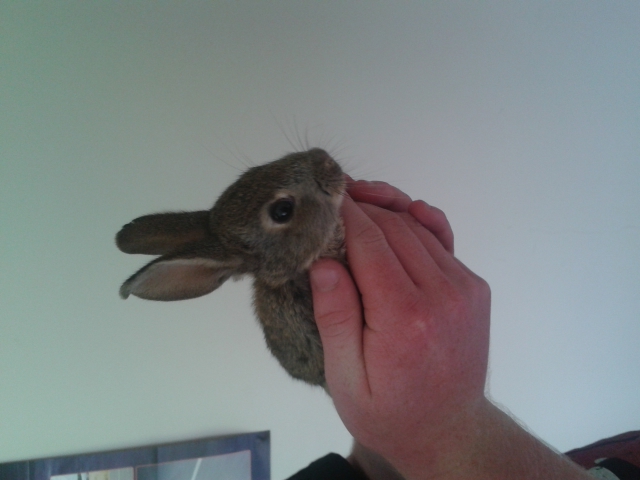 Wild Rabbit Kitten
Question
Rabbit Kitten
This morning we woke up t
Wild Rabbit Kitten
Question
Rabbit Kitten
This morning we woke up t
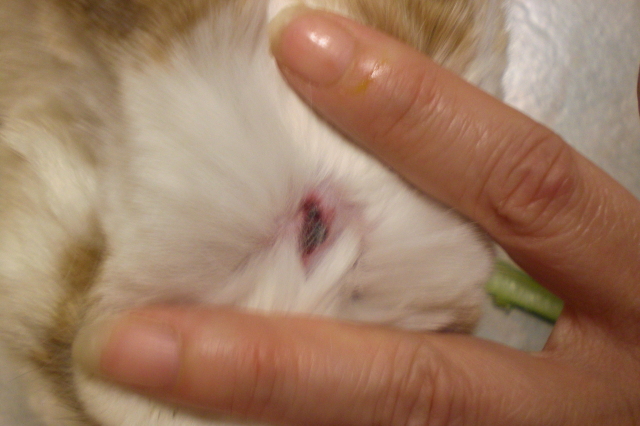 Rabbit acting different?
QuestionQUESTION: Hi, I recently found out that my rabb
Rabbit acting different?
QuestionQUESTION: Hi, I recently found out that my rabb
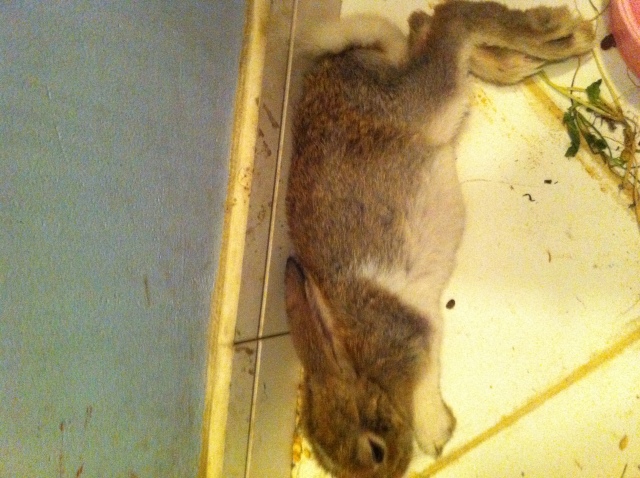 how do i know which day is my rabbit pregnant?
Questionmy pregnant rabbit
QUESTION: how do i kn
how do i know which day is my rabbit pregnant?
Questionmy pregnant rabbit
QUESTION: how do i kn
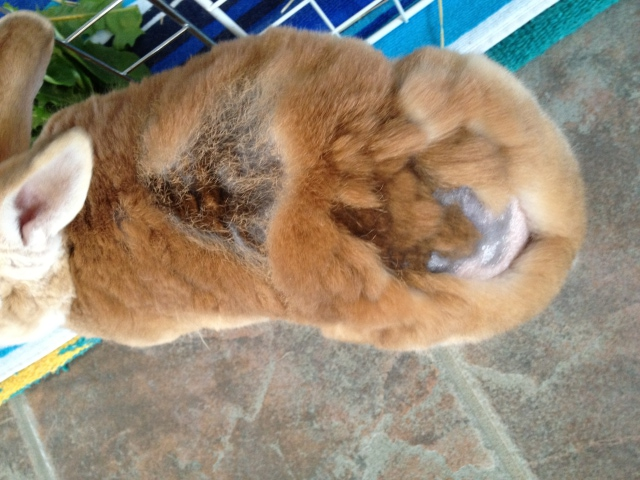 Fungal Infection
Question
Fungal Infection
Dear Dr. Krempels,
I
Fungal Infection
Question
Fungal Infection
Dear Dr. Krempels,
I
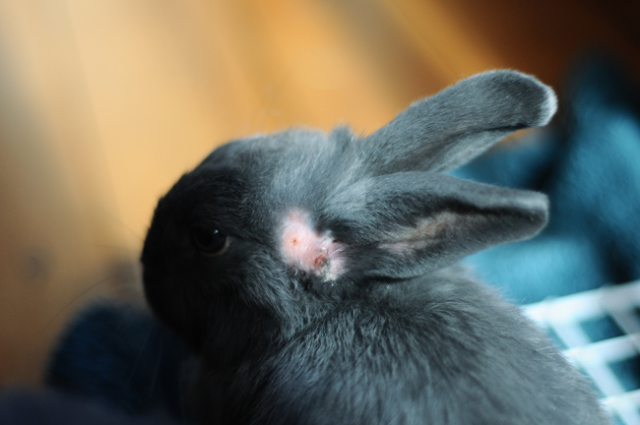 Mass under the ear.
Question
Minas ear.
Hello Dr,
My six months old
Mass under the ear.
Question
Minas ear.
Hello Dr,
My six months old